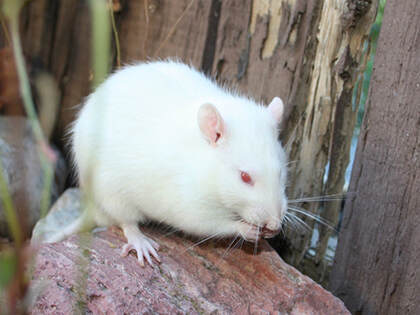Pink Eyes Freak You Out?

Pink-Eyed Whites have a long history in the rat fancy. The Albino rat (officially known as the Pink-Eyed White or PEW) is most likely the very first mutation to be discovered and purposely bred. Albinism is a very common mutation even in wild populations, showing up in many animals including dogs, horses, ferrets, rabbits, cavies, and many others including rats and mice. Naturally, the white coats and pink eyes of these animals would make it very difficult for them to survive in the wild. Discovered by someone with an interest in animals, however, an oddly colored white rat might well have been captured rather than killed. (The Pink-Eyed White Rat by Nichole Royer)
Albino
Albinism is a simple recessive trait. It should be kept in mind that the Albino gene covers up or “prevents the expression” of whatever color or pattern happens to be present on the rat. The color and pattern are still there, you just can’t see them. Most of the PEW rats currently kept by fanciers are actually Hooded. There are actually two types of PEW rats out there. The first one we see most commonly is the true Albino. The second kind is simply pink-eyed Marked (Capped or Masked) rats which have been selected for less and less color. Eventually you get rats that are white all over with pink eyes. (The Pink-Eyed White Rat by Nichole Royer)
Eyes
Albinos have a number of differences in their visual systems compared to normally pigmented animals. In a nutshell, albinos have no pigment — no melanin — in their eyes. This means no pigment in the iris. That’s why the iris looks red — the only color left comes from blood in the capillaries. Albinos also lack pigment deeper in the eye, pigment which normally absorbs light. Without it, light inside the eye scatters. The consequence is that the albino’s eye is flooded with light. Over time, the light causes retinal degeneration. In addition to all this, albinos have abnormal neural connections between the eyes and the brain. The end result of all this is that albino rats have very poor vision. (http://www.ratbehavior.org/)
Albino
Albinism is a simple recessive trait. It should be kept in mind that the Albino gene covers up or “prevents the expression” of whatever color or pattern happens to be present on the rat. The color and pattern are still there, you just can’t see them. Most of the PEW rats currently kept by fanciers are actually Hooded. There are actually two types of PEW rats out there. The first one we see most commonly is the true Albino. The second kind is simply pink-eyed Marked (Capped or Masked) rats which have been selected for less and less color. Eventually you get rats that are white all over with pink eyes. (The Pink-Eyed White Rat by Nichole Royer)
Eyes
Albinos have a number of differences in their visual systems compared to normally pigmented animals. In a nutshell, albinos have no pigment — no melanin — in their eyes. This means no pigment in the iris. That’s why the iris looks red — the only color left comes from blood in the capillaries. Albinos also lack pigment deeper in the eye, pigment which normally absorbs light. Without it, light inside the eye scatters. The consequence is that the albino’s eye is flooded with light. Over time, the light causes retinal degeneration. In addition to all this, albinos have abnormal neural connections between the eyes and the brain. The end result of all this is that albino rats have very poor vision. (http://www.ratbehavior.org/)
